Veiled Prophet Ball
The Veiled Prophet Ball is a dance held each December in St. Louis, Missouri, by the "Veiled Prophet Organization", founded by prominent St. Louisans in 1878. Each year, one member of the Veiled Prophet Organization is chosen to serve as the "Veiled Prophet of Khorassan," to preside over the Veiled Prophets Ball. Five of the debutantes (all attend by invitation only) are chosen by secret process to make up the "Veiled Prophet's Court of Honor." One is chosen to be crowned the "Queen of Love and Beauty" by the Veiled Prophet.
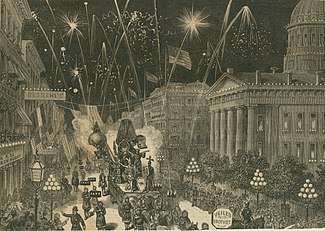

The founders' intent was to create an annual local celebration similar to Mardi Gras in New Orleans, eventually to include pageantry and costuming as well as a parade with floats.
Events also included the Veiled Prophet Fair (or "VP Fair"). In the face of increasing criticism of using civic resources to support a socially exclusive organization, this was renamed as Fair St. Louis in 1992 and broadened in appeal.
Early history
Origins
The event had its roots in the St. Louis Agricultural and Mechanical Fair, an annual harvest festival which had been held in St. Louis since 1856. It attracted agricultural crops, crafts, demonstrations and attendees from throughout the region. In the economic difficulties after the American Civil War in the 1870s, such events declined. City boosters devised the Veiled Prophet Fair in an attempt to reclaim, from the rapidly growing city of Chicago, pre-eminence for St. Louis as a manufacturing center and agricultural shipping point.
On March 20, 1878, Charles Slayback, a grain broker (who had spent several years in New Orleans after the Civil War and become acquainted with its Mardi Gras traditions) called a meeting of local business leaders at the Lindell Hotel. Together with his brother Alonzo, Slayback created a mythology for a secret elite society, whose public demonstrations would coincide with the annual fair. From Irish poet Thomas Moore, the Slaybacks borrowed the name of the Veiled Prophet of Khorassan; they also incorporated features from the Mystick Krewe of Comus of New Orleans. In their version, the Prophet was a world traveler who had made St. Louis his home base. The first parade, attracting over 50,000 spectators, and grand ball were staged that year on October 8, 1878.
Intentions
According to historian Thomas M. Spencer of Northwest Missouri State University, "boosting trade was one of the main goals of the Veiled Prophet organization," and "class control" was "a second, equally important objective." Spencer wrote: "Newspaper feature stories since the 1950s have described the 'first Veiled Prophet parade' as a way of healing the wounds of a bitter labor-management fight,' the strike of 1877. However, the first Veiled Prophet parade was more a show of force than a gesture of healing."[1]
He commented on a depiction featured in the October 6, 1878 Missouri Republican of the Veiled Prophet dressed as a Klansman with a white hood and robe while armed with a pistol and rifle. This depiction of the Veiled Prophet is contradicted by the St. Louis Post-Dispatch's description of the 1878 parade which provides a physical description consistent with the traditional appearance of the Veiled Prophet being "costumed in green and red" and having "a mosquito bar over its face." [2] The Missouri Republican article commented, "It will be readily observed from the accoutrements of the Prophet that the procession is not likely to be stopped by street cars or anything else."(October 6, 1878) Historian Spencer interpreted the reference of the Republican to "streetcars" as related to the 1877 labor strike. Lucy Ferriss wrote about the VP events in her memoir.[3]
Selection of Prophet
The Prophet was selected secretly from among male members, who were made up of St. Louis' business and civic elite. The first prophet was Police Commissioner John G. Priest. Although the identity of a given year's Grand Oracle, or Veiled Prophet, was officially a secret, early holders of the office were reported to include Col. Alonzo W. Slayback, Capt. Frank Gaiennie, John A. Scudder, Henry C. Haarstick, George Bain, Robert P. Tansey, George H. Morgan, Col. J. C. Normile, Wallace Delafield, John B. Maude, Dr. D. P. Rowland, Charles E. Slayback, Leigh I. Knapp, David B. Gould, Henry Paschell, H. I. Kent, Dr. E. Pretorious, Win. H. Thompson, and Win. A. Hargadine.
Selection of Queen
The Queen of Love and Beauty, and later maids of honor, were to be selected by the Veiled Prophet from among the debutantes who had received invitations to the ball. (The list of invitees was determined by a process never made public. The supply of tickets was limited to members of the VP organization, which had a secret constitution, and the assignment of these non-transferable tickets required the organization's approval.) The Veiled Prophet would dance the "Royal Quadrille" with the Queen, and then award her some keepsake of the occasion. Over the years, the Queens and their courts received pearl necklaces or silver tiaras, which became family heirlooms (as did the elaborate invitations themselves).
In 1928, Mary Ambrose Smith, who was selected as Queen, was found to have secretly married Dr. Thomas Birdsall days earlier, violating the rule that the Queen of Love and Beauty must be a "maiden." In a 1979 interview with the St. Louis Times, Smith recalled how the Veiled Prophet
gave her travelling money and told her to "begone, don't register at any large hotels, and don't use your real name."... Smith was "made to feel she disgraced her family. None of her friends stuck by her (she was told she could not visit their houses), she was never invited to another VP ball, her picture was removed from the collection of queens' portraits at the Missouri Historical Society, and her name was deleted from the Social Register.
Later history
The ball, parade and fair became an established St. Louis tradition, though not without controversy. According to the official St. Louis city government website, "The traditional VP celebration has represented for St. Louisans a perceived link between different components of the community in a holiday celebration, while also reinforcing the notion of a benevolent cultural elite."[4] Historian Thomas M. Spencer believes that the event generally revealed rather than soothed class conflicts. In 1882, public objections were raised by Irish Americans to a float which featured that ethnic group, and it was withdrawn from the parade. .[5] Assaults by onlookers against the floats with pea-shooters, rocks and other missiles took place. Confectioners' shops stocked the pea-shooters in anticipation of the parade, one observer recalled.[6]
The VP parade had been deliberately created in part to displace the parades regularly held by the trade unions. Spencer believes it cast workingmen in a passive rather than active role, not merely in the celebration, but in the mythology asserted for the history and economic life of the city.[7] Occasionally the unions would stage events intended to mock the pretensions of the VP Ball.[8] The leading socialist and working-class newspaper, St. Louis Labor, "wrote negatively" about the VP event and its organizers for decades.[9]
But the parade continued to attract large crowds and exerted a certain fascination. In 1949, for the first time, the ball was broadcast on KSD-TV (now KSDK), and the station estimated that more than 80% of area viewers tuned in. According to historian Spencer, "Most St. Louisans probably enjoyed the 'fairy tale' nature of it. By watching the ball, they were vicariously living the experiences of the elites dancing across their television screens." According to Harry Levins, "The parade was aimed at boosting the spirit of the city's common folk. The ball was aimed at reassuring the city's elite of their exclusive status." The early pageants had been partially meant to move working-class viewers to awe at the accomplishments of great men, all of whom were said to be ancestors of the Prophet.[7]
By 1969, the ball was the object of civil rights protests, resulting in numerous arrests. Percy Green and the civil rights group Action Committee to Improve Opportunities for Negroes ("ACTION") conducted numerous protests against VP activities. It was said that editorial staffs suppressed much of the reporting of the protests by ACTION against VP activities. Patrick J. Buchanan, then an editorial writer for the Globe-Democrat newspaper, particularly portrayed the group as radical dissidents.[10]
On December 22, 1972, in Kiel Auditorium, the most dramatic event occurred when Gena Scott slid down a power cable and unmasked the Prophet, who that year was Monsanto Company executive vice president Tom K. Smith, according to the St. Louis Journalism Review. She was aided by Jane Gottlieb, who created a diversion by throwing papers onto the crowd from a high railing.[11] Newspapers at the time did not print his identity, although likely at least a hundred people saw him.[10]
In continuing reaction, Scott's car was bombed near her apartment. Her place was vandalized numerous times.[10] (Lucy Ferriss explores these events in her memoir, Unveiling the Prophet. Her aunt Ann Chittenden Ferriss, was selected as the 1931 Queen of Love and Beauty). The unveiling of the Prophet was the most dramatic disruption in ACTION's long campaign (1965-1976) to encourage the many CEOs in the VP Organization to hire more minority workers at their businesses. While VP spokesmen said they took no notice of ACTION, its leader, Percy Green, had been laid off in 1964 and never was able to get another job for a St. Louis corporation.[10]
The activists encouraged disbanding the VP organization so that public and private funds could be spent on worthier projects. Spencer sees the unveiling at the Ball as a crucial moment in a long process of disintegration of the civic unity and class harmony that the VP Fair claimed to celebrate. According to Spencer, by the late 1970s, the wives and daughters of the elite, for whom the Ball constituted a sort of marriage-market, had become resistant to its inherent sexism.[12] Even members of the VP Organization began to express distaste: William Maritz, a one-time Veiled Prophet, said, "'A lot of members' in the late 1970s 'felt uneasy with the social connotations' and that 'people were saying 'get that godamned ball off of television, don't force that on the community."
The subversive act of unveiling the Prophet revealed what Spencer said had been the classist underpinnings of the event from its inception. Only in 1979 did the Veiled Prophet Organization admit its first black members. In 1981, fair officials were confronted with accusations of racism when they closed the Eads Bridge to pedestrian access, which reduced the ability of attendees from mostly black East St. Louis from reaching the fair. According to Ronald Henges, "People just didn't want other people flaunting their wealth and their position."[13]
The 1980s and 1990s saw the Veiled Prophet Organization become more secretive as the group took steps to lessen its public profile. The Veiled Prophet Ball was reworked in order to be a more private event and the parade changed to be more focused towards general entertainment, though the Veiled Prophet and his entourage still rode in the Parade.[14] The largest change came in 1992 as the VP Fair was renamed to Fair St. Louis, removing all reference to the Veiled Prophet in the Fair's name. Because of construction related to redesign of roadways and the National Gateway Arch Memorial, Fair St. Louis was moved to Forest Park in 2014 and was to be held there in 2015. Fair organizers were pleased with turnout and arrangements for managing access to the fair.
Location
Due to the demands of world wars, the ball was suspended for the years 1917-1918 and from 1942 through 1945. When the ball was resumed after World War II, critics began to object to using Kiel Auditorium, a civic facility, for such a socially exclusive event. In the 1950s, the Chase Park Plaza Hotel constructed the opulent Khorassan Ballroom specifically to host the annual debutante ball, and the event was moved there.
Beginning in 1974 the "Veiled Prophet Fair" was held on the riverfront.
Since the turn of the 21st century, the Ball has been held at the Downtown St. Louis Hyatt at the Arch.
The Fair was moved from the riverfront to Forest Park in 2014 and 2015 due to construction in the area around the Gateway Memorial Arch and reworking of roadways and the park.
Gallery
.jpg) Program title page, 1883
Program title page, 1883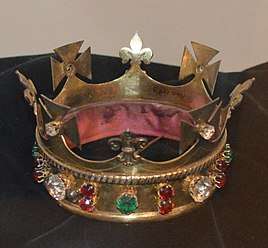 Maid's crown, 1894
Maid's crown, 1894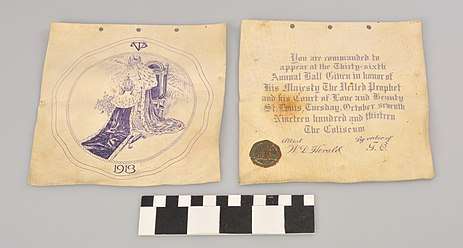 Ball invitation, 1913, with photographic marker at the bottom
Ball invitation, 1913, with photographic marker at the bottom
Veiled Prophet queens

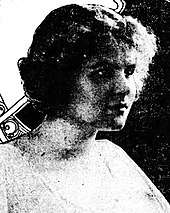

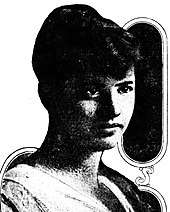
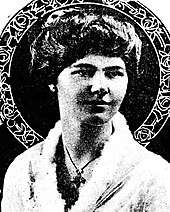
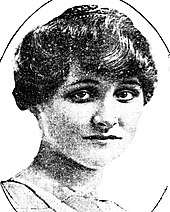
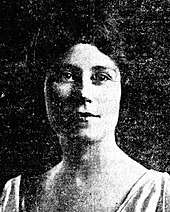
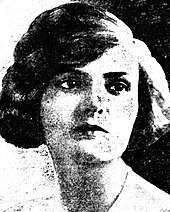
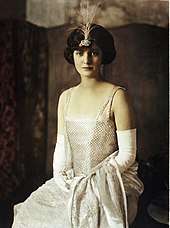
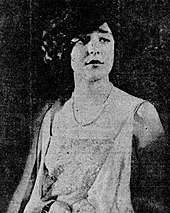
.jpg)
The Veiled Prophet queens have included:
- 1878 Susie Slayback
- 1885 Virginia Joy[15]
- 1886 Louise (Lulu) Scott[15]
- 1887 No queen due to visit of President and Mrs. Grover Cleveland
- 1888 Louise Galennie[15]
- 1889 Miss Wain (from Cleveland)[16]
- 1890 Katherine (Kate) Hill[15]
- 1891 July Thompson[15]
- 1892 Ellen Sturges[15]
- 1893 Florence Lucas
- 1894 Hester Bates Laughlin [17][18]
- 1895 Bessie Kingsland[17]
- 1896 Mary Louise McCreery[17]
- 1897 Jane Dorothy Fordyce[17]
- 1898 Marie Theresa Scanlan[17]
- 1899 Ellen H. Walsh[17]
- 1900 Susan Larkin Thomson[17]
- 1901 Emily Catlin Wickham[17]
- 1902 Maud Wells[17]
- 1903 Lucille Chouteau[17]
- 1904 Stella Wade[17]
- 1905 Julia Cabanne[17]
- 1906 Marguerite Kehlor Tower[17]
- 1907 Margaret Cabell[17]
- 1908 Dorothy Shapleigh[17]
- 1909 Susan Rebecca Carleton[17]
- 1910 Lucy Norvell[17]
- 1911 Ada Randolph[17]
- 1912 Jane Taylor[17]
- 1913 Adaline Capen[19]
- 1914 Elsa Zeibig[20]
- 1915 Jane Shapleigh
- 1916 Mary D. Jones[21]
- 1917-1918 (No ball because of World War I)
- 1919 Marian Franciscus
- 1920 Ada R. Johnson
- 1921 Eleanor Simmons
- 1922 Alice Busch
- 1923 Grace Wallace
- 1924 Mary Virginia Collins
- 1925 Maud Miller Streett
- 1926 Martha Love
- 1927 Anne Farrar Semple
- 1928 Mary Ambrose Smith (disqualified due to secret marriage)
- 1929 Jean Wright Ford
- 1930 Jane Perry Francis
- 1931 Ann Chittenden Ferriss
- 1932 Myrtle McGrew Lambert
- 1933 Jane Alva Johnson
- 1934 Jane Wells
- 1935 Lila Marshall Childress
- 1936 Susan Elizabeth Thompson
- 1937 Nancy Lee Morrill
- 1938 Laura Hale Rand
- 1939 Jane Howard Smith
- 1940 Rosalie McRee
- 1941 Barbara Wear
- 1942-1945 (No ball because of World War II)
- 1946 Anne Kennett Farrar Desloge
- 1947 Dorothy Claggett Danforth
- 1948 Helen Dozier Conant
- 1949 Carol Moon Gardner
- 1950 Eleanor Koehler
- 1951 Mary Kennard Wallace
- 1952 Sally Baker Shepley
- 1953 Julia Terry
- 1954 Barbara Anne Whittemore
- 1955 Audrey Faust Wallace
- 1956 Helene Brown Bakewell
- 1957 Carol Lammert Culver
- 1958 Carolyn Lee Niedringhaus
- 1959 Laura Rand Orthwein
- 1960 Sally Ford Curby
- 1961 Anne Marie Baldwin
- 1962 Diane Waring Desloge
- 1963 Anne Kennard Newhard
- 1964 Alice Busch Condie
- 1965 Rebecca Wells Jones
- 1966 Jane Howard Shapleigh
- 1967 Rosalie McRee Ewing
- 1968 Rebecca Dixon Williams
- 1969 Josephine Carr Brodhead
- 1970 Phoebe Mercer Scott
- 1971 Lenita Collins Morrill
- 1972 Hope Florence Jones
- 1973 Susan Mitchell Conant
- 1974 Susan Clark Smith
- 1975 Sarah Hitchcock Moore
- 1976 Cynthia Gray Danforth
- 1977 Gertrude Marie Busch
- 1978 Elizabeth Courtney Johnson
- 1979 Susan Pierson Smith
- 1980 Eleanor Church Hawes
- 1981 Talbot Peters MacCarthy
- 1982 Alice Maritz
- 1983 Elizabeth Ford Johnston
- 1984 Mary Genevieve Hyland
- 1985 Jennifer Lee Knight
- 1986 Stephanie Marie Schnuck
- 1987 Emily Shepley Barksdale
- 1988 Elizabeth Gray Elliott
- 1989 Alice Marie Behan
- 1990 Carter Gedge Walker
- 1991 Katherine Hall McDonnell
- 1992 Kelly Taylor
- 1993 McKay Noland Baur
- 1994 Margaret Dunne Hager
- 1995 Martha Elizabeth Matthews
- 1996 Elizabeth Ann Bryan
- 1997 Rosalie Ewing Engler
- 1998 Josephine Marie Condie
- 1999 Elizabeth Claire Kemper
- 2000 Carolyn Elizabeth Schnuck
- 2001 Julia Ryerson Schlafly
- 2002 Lucy Hager Schnuck
- 2003 Lauren Morgan Dorsey Thomas
- 2004 Elizabeth Garrett Benoist
- 2005 Julie Anne Stupp
- 2006 Janice Hope Jones
- 2007 Katherine Remington Martin
- 2008 Elizabeth Bunn Hailand
- 2009 Melissa Benton Howe
- 2010 Laura Hogan Hollo
- 2011 Eleanor Clark Brennan
- 2012 Margaret Frances Schnuck
- 2013 Katherine Falk Desloge
- 2014 Merrill Clark Hermann
- 2015 Charlotte Capen Jones
- 2016 Eliza Dooley Johnson
- 2017 Corinne Marie Condie
- 2018 Cecelia Ann Fox
- 2019 Lily Shelton Baur
See also
- Fleur de Lis Ball - St. Louis' other debutante cotillion
- Jewel Ball - another debutante cotillion in Missouri
References
- Thomas M. Spencer, The St. Louis Veiled Prophet Organization: Power on Parade, 1887-1995, Columbia and London: University of Missouri Press,2000
Citations
- Spencer (2000), p. 7-8
- "The Veiled Prophet." St. Louis Post-Dispatch, October 9, 1878, page 5
- Lucy Ferriss, Unveiling the Prophet
- History and Culture, St. Louis City Government
- Spencer, p. 45-46
- Spencer, p. 75
- "Order of the Veiled Prophet", St. Louis Post Dispatch, January 13, 2004
- District 8 and movement unionism, Northern Illinois University
- Spencer, p. 77-78
- Spencer (2000), pp. 134-136
- YoungSaintLouis.com
- Spencer (2000), pp. 138-9
- Spencer (2000), p. 140
- Mooney-Melvin, Patricia. "The St. Louis Veiled Prophet Celebration: Power on Parade, 1877-1995." The Annals of Iowa 60 (2001), 295-297.
- Marguerite Martyn, "The Veiled Prophet's Early Visits to His City," St. Louis Post-Dispatch, October 7, 1931, image 30
- [https://www.newspapers.com/image/138229774/?terms=Veiled%2BProphet%2Bmiss%2Bwain "The Prophet's Pageant," St. Louis Post-Dispatch, October 9, 1889, image 9
- "List of Queens Chosen by the Veiled Prophet Since 1894," St. Louis Globe-Democrat, October 6, 1915
- Hester Bates Laughlin was the first of the crowned queens. Before, "it had been the custom of the Prophet to select a girl for his partner in the first dance at the ball."
- "Adaline Capen's Red Hair Reveals Her as V.P. Queen," The New St. Louis Star, October 8, 1913, image 1
- "Elsa Zeibig Is Crowned Queen at Ball of V.P., St. Louis Post-Dispatch, October 7, 1914, image 1
- "Veiled Prophet's Ball a Brilliant Community Fete," St. Louis Post-Dispatch, October 4, 1916, image 3
Other reading
- Darst, Katherine. "The Prophet's Pearls", The St. Louis Magazine, Vol. 1, No. 4, Sept. 1963.
- Ferriss, Lucy. Unveiling the Prophet: The Misadventures of a Reluctant Debutante. U-MO Press, 2005.
- Nance, Susan. "The Veiled Prophet's Oriental Tale: St. Louis' Famous Festivals in Context, 1878-1895." Missouri Historical Review 103, no. 2 (January 2009): 90-107.
- Stevens, Walter B. St. Louis The Fourth City, 1764-1909, S.J. Clarke Publishing Co., 1909.